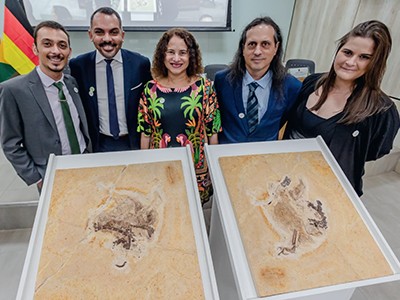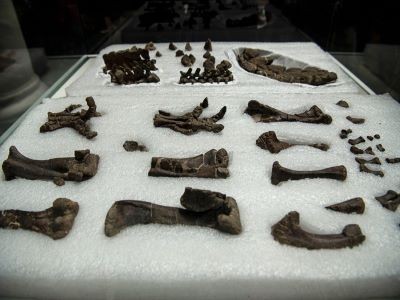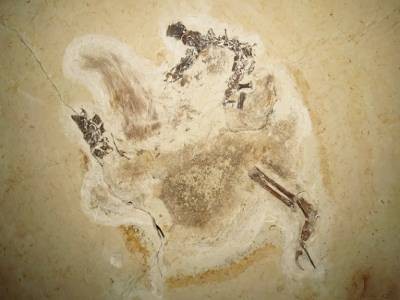In two separate expeditions 150 years ago, soldiers, scientists and mineral prospectors entered the lands of Lakotan people. This was just six years after the United States had formally recognized Lakotan sovereignty in the region.
In July 1874 — in the better known of the two expeditions — an ambitious young lieutenant colonel named George Armstrong Custer led more than 1,000 heavily armed troops into the Black Hills, a mountain range in what is now western South Dakota and eastern Wyoming. The official aim of the expedition was to map the area and find a suitable location to build a military fort, “to take the hostile backbone out of these unruly savages”, according to a high-ranking army commander1. But Custer had also recruited a team of geologists, mineral prospectors and journalists to accompany his soldiers, in the hope of precipitating a gold rush.
The second expedition was led by Othniel Charles Marsh, a pre-eminent palaeontologist at Yale University in New Haven, Connecticut. In November that year, Marsh unearthed two tonnes of prehistoric fossils and shipped them to the Yale Peabody Museum of Natural History.
Scientific societies have a part to play in repatriating fossils
Custer’s expedition is often used to demonstrate the ruthless tactics deployed by the United States to colonize Native American lands. Marsh’s venture is generally seen in a more benign light, as an effort to further humanity’s understanding of Earth’s history. But a closer look at what happened in 1874, and in the years that followed, reveals that Marsh also contributed to the dispossession of Native American people. He extracted countless specimens from Lakotan lands without permission. When he shipped the fossils to Connecticut, most of the Lakotan meanings and stories tied to them were stripped away. Perhaps most egregiously, Marsh’s specimens were subsequently used to support an erroneous, racist theory of evolutionary progress that was deployed to justify the imperial expansion of the United States.
Around the world, archaeologists and anthropologists have taken steps to confront the darker side of their disciplines’ histories. In the United States, as of this January, federal law mandates that museums obtain “free, prior, and informed consent” from lineal descendants, American Indian Tribes and Native Hawaiian organizations before they exhibit human remains or cultural items (see go.nature.com/3wcvcvh). A similar reckoning for the Earth sciences — including a rethink of where and how natural history collections are curated — could help to rebuild Indigenous communities’ trust in science globally. It could also promote a greater diversity of perspectives on the natural world.
Material motives
According to Lakotan people (the Native American Nation now has more than 115,000 citizens), they have always lived in Paha Sapa, as they call the Black Hills. When strangers first started entering their hunting grounds — often in search of material wealth — Lakotans exchanged animal pelts with them for weapons and other goods. But over time, the flow of migrants led to rising tensions, particularly around the hunting of buffalo (Bison bison)2.
Lakotan people were not just dependent on the buffalo for their livelihoods; they also viewed them as relatives. Whereas the region’s Indigenous people agreed not to hunt animals beyond what was needed, migrants began slaughtering buffalo on a massive scale, in part to limit the power and mobility of the Indigenous groups.
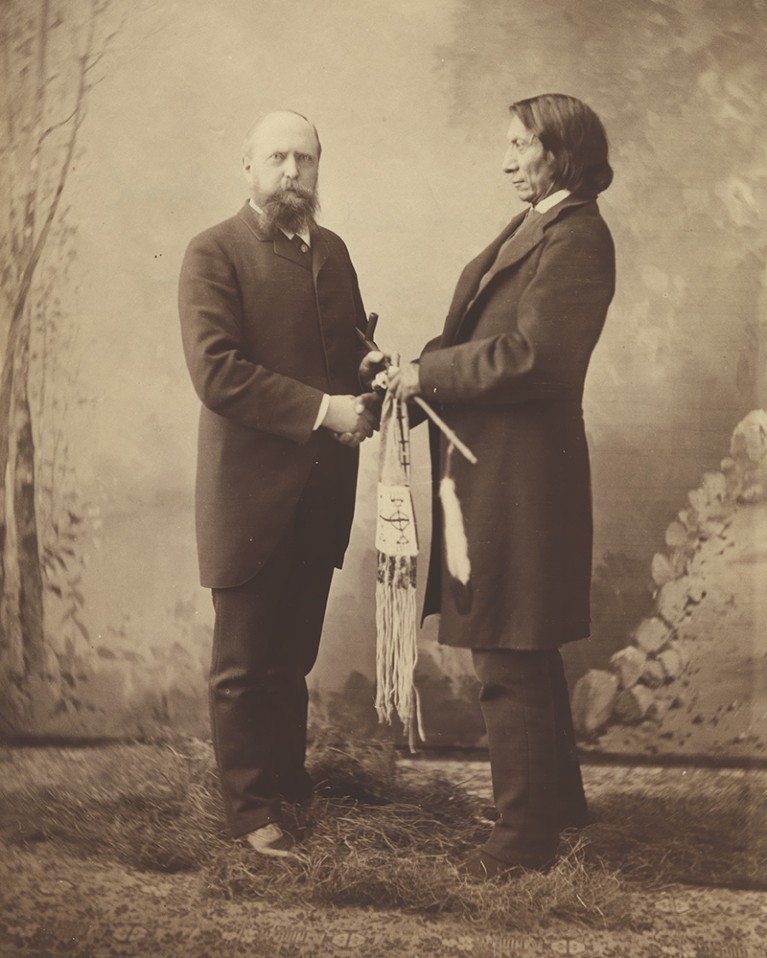
Othniel Charles Marsh (left) posing with Mahpiya Luta in a photographer’s studio.Credit: National Portrait Gallery, Smithsonian Institution
Hoping to curb the influx of migrants, a leader named Mahpiya Luta (Red Cloud), the head of a group of Lakotan people called the Oglala, forged a powerful alliance with the Cheyenne and Arapaho peoples, two other Native American Nations. When it became clear that the United States was failing to prevail on the battlefield, the federal government sued for peace and convened a treaty council in 1868 at Fort Laramie, in present-day Wyoming. After this meeting, the United States agreed to recognize Lakotan sovereignty in a swathe of territory about the size of Spain. This region, covering portions of what is now South Dakota, North Dakota, Montana, Wyoming and Nebraska, includes the Black Hills and the White River Badlands, a geological formation that is rich in vertebrate fossils, which range from 27 million to 37 million years old.
Custer’s expedition six years later almost immediately attracted countless migrants to the treaty lands. In August 1874, before Custer’s scientists had even finished their work, expedition journalists dispatched several reports to newspapers across the United States touting the region’s rich mineral resources. As well as making front-page headlines in newspapers such as the New York Tribune, Custer’s exploits were publicized in books, pamphlets, maps and advertisements. Some of the most sensational reports were printed by the US Land Office, as well as by railroad companies that sought to profit from westward migration.
For Marsh, it wasn’t rumours of the Black Hills’ rich mineral deposits that drew him to the region, but reports from military surveyors of a “vast deposit of fossil remains” in northern Nebraska3.
How rich countries skew the fossil record
Custer had actually invited Marsh to join his July expedition. But Marsh had declined, sending his most promising student, George Bird Grinnell, instead. Later that year, however, Marsh set out for the treaty lands. When he arrived at the Red Cloud Agency, a military post where the US government distributed money and supplies to Indigenous people, Marsh found that the assembled Indigenous groups were highly suspicious of his interest in fossils. According to a 22 December 1874 article in the New York Tribune, a meeting was convened during which White Tail, one of the Lakotan leaders, “sprang at once to his feet”, declaring “that the proposed bone-seeking was merely a ruse to begin digging for gold and invading the Black Hills”.
After a tense and protracted negotiation, Red Cloud agreed to let Marsh enter the Badlands as long as he was escorted by Lakotan guides, and as long as he promised to tell federal officials in Washington DC that a government officer in charge of the Red Cloud Agency was distributing poor-quality supplies and embezzling funds. According to the Tribune article, Marsh accepted, but when it became clear that the Lakotans were growing increasingly suspicious of his true motives, he resolved to leave for the White River Badlands without his guides, under the cover of darkness.
Over the next few days, Marsh and his military escort excavated cartloads of fossils — including the massive remains of extinct ungulates that Marsh named Brontotheriidae — all under the watchful eye of Lakotan warriors who had quickly realized what he was up to. Writing in the 17 November 1874 edition of the New York Tribune, a newspaper journalist even joked that “the search for fossils instead of that for gold may unlock the gates of the Black Hills”.
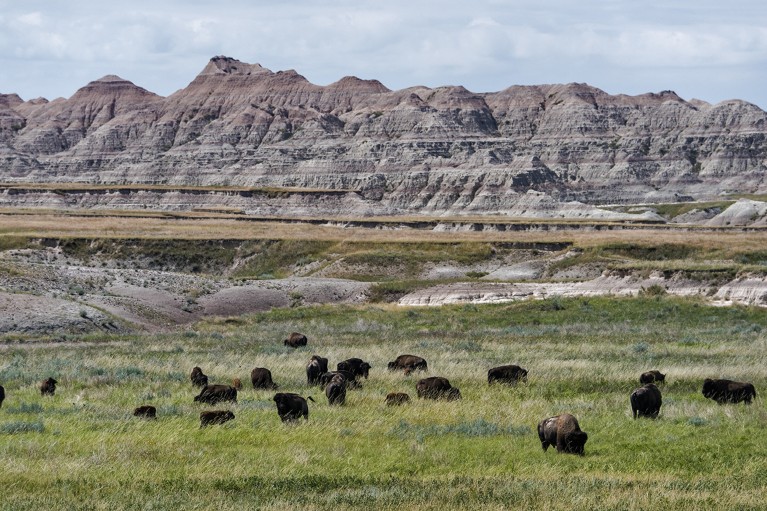
Lakotan people depended on the hunting of buffalo for food and pelts.Credit: Mark Newman/Getty
Marsh was not the only scientist to extract knowledge and research materials from Lakotan treaty lands. Many fossils have been taken from the region over the years, often without permission4. After the initial discoveries of 1874, Marsh sent his assistant John Bell Hatcher to find more specimens for the Peabody Museum. Over the next several decades, scientists from the American Museum of Natural History in New York City also collected specimens in the treaty lands, resulting in the publication in 1929 of a massive treatise on the region’s extinct ungulates by the museum’s president, Henry Fairfield Osborn5. But Marsh’s findings helped to support the imperial expansion of the United States in a more insidious way, too.
According to Marsh and his colleagues, extinction had a role in evolutionary advancement by creating ecological space for new and more advanced lineages. This idea — that certain less-evolved races are doomed to extinction, known as ‘racial senescence’ — was widely embraced by intellectual elites at the time. And it was used to support claims that North America’s Indigenous nations were naturally destined to disappear6. In other words, a speculative theory about evolution bolstered by fossils extracted — illegally — from treaty lands was invoked to justify the dispossession of those same lands by portraying their original inhabitants as naturally doomed to extinction.
Genuine collaborations
Today, the involvement of scientists such as Marsh in the colonization of North America is rarely discussed. A recently renovated exhibition about vertebrate fossils at the Peabody Museum, for instance, acknowledges the historical tensions between scientists and Native American people. But it also suggests that a more collaborative relationship existed between Marsh and Lakotan people than the evidence indicates. For example, one sign explains that Marsh was inspired by Lakotan stories about thunder beings (Wakiŋyaŋ) when he decided to use the Greek word for thunder beast to name the extinct ungulates he had excavated ‘brontotheres’. Wakiŋyaŋ are bird-like spirits whose conflict with ancient monsters called uŋhcegila is often used by Lakotan people to explain the abundance of fossils in the White River Badlands.
Prized dinosaur fossil will finally be returned to Brazil
In our view, Earth scientists and natural history museums should foster further conversations about the ways in which their disciplines and institutions are entangled with the violent history of colonialism. Some have already begun to take important steps in this direction. The Natural History Museum in Berlin, for example, has created an interdisciplinary research centre, involving historians, anthropologists and natural scientists, to explore the provenance of its collections.
We encourage more interdisciplinary research of this kind. More museums and universities should create scholarships to make their collections easily accessible to students and researchers from the lands from which they were extracted. Furthermore, scientists could do much more to forge reciprocal relationships with people on whose lands they wish to work — for instance, by discussing potential collaborations with local partners before submitting a funding proposal. Finally, we think that where and how natural history collections are curated should be re-evaluated.
There are clear legal arguments for repatriating fossils extracted from the White River Badlands. The 1868 Treaty of Fort Laramie — which, according to a 1980 ruling by the US Supreme Court, remains in effect — explicitly sets aside the lands around the Black Hills for the “absolute and undisturbed use and occupation” of Lakotan people (see go.nature.com/4ar2cat). Why should this language not cover the extraction of specimens?

Legends around the fossils include stories about a great race involving animals.Credit: Angela Babby
Implicitly or explicitly, it is often assumed that because Earth sciences deal with rocks and fossils, rather than with artefacts or human remains, they should not be held to the same ethical standards as anthropology and archaeology. In 1999, for example, under the Native American Graves Protection and Repatriation Act (NAGPRA), the Confederated Tribes of the Grand Ronde Community of Oregon asked for the return of a sacred meteorite called Tomanowos, or ‘sky person’. Describing the specimen as “a feature of the landscape”, the American Museum of Natural History denied the tribe’s claim and filed a federal lawsuit in 2000 to clarify that “NAGPRA does not cover this type of object”7. In support, an editorial in The New York Times stated that the meteorite “is a celestial object” that “belongs to us all, and is best left in the custody of the museum”. Similar arguments are often made for fossils that pre-date the evolution of humans8.
This line of reasoning overlooks the very different relationships between nature and culture, prehistory and the present that characterize the cosmology of Lakotans and many other Indigenous cultures worldwide.
The Lakotan creation story — the narrative of how Lakotan people came to be, passed down through generations — begins with Iŋyaŋ (stone). Iŋyaŋ existed before there was anything else, but he wanted something over which he could exercise his power. So he opened his veins and spread his blood in a great disk all around himself to create Maka (Earth). Because Iŋyaŋ was unable to staunch the flow of blood, his body became brittle and dry, and he was scattered all over Maka. From this initial sacrifice, everything else followed, including the sky, the Sun, the Moon, the plants and the animals9.

All animals came together for the start of the great race, according to legend.Credit: Del Iron Cloud
According to Luther Standing Bear, who worked to uphold Lakotan culture and sovereignty in the late nineteenth century, the creation story reminds Lakotans that they came from Maka, which in turn provides “the foundation for the love they bore for earth and all the things of the earth”10. These teachings are reinforced by ceremonies, such as the sweat lodge, a ritual that involves pouring water over hot stones while offering prayers to Tuŋkasila (grandfather or creator). As Albert White Hat, a respected teacher of Lakotan language and culture, explains11: “Whether it’s the spirit of the eagle, or the coyote, or the spider, whatever spirit comes in the lodge, I address them as Tuŋkasila … because they represent the beginning of time until today. And they are my relatives, they are dear to me.”
The Lakotan saying Mitakuye Oyasiŋ, or ‘We are all related’, extends beyond humans to encompass everything in the treaty lands — including plants and animals, stones, the sky, fossils, thunderstorms and Earth itself. All are part of a complex network of relationships forged out of mutual dependence and reciprocity. In our view, museums have an ethical duty to return fossils extracted from the White River Badlands, not just because of the 1868 agreement, but because fossils are an integral part of the system of relationships that brings order to all life in the treaty lands.
Diverse world views
The realization that extractive capitalism is unsustainable is leading to a growing interest in how Lakotans and other Indigenous people relate to Earth2. By partnering with Native American Nations to build museums on tribal lands, institutions such as the Peabody Museum could help to develop exhibits that present a much richer picture of the stories, meanings and interpretations tied to fossils than is currently possible.
Visitors could learn, for example, how a series of uplifts followed by erosion, which extend as far back as the Precambrian period (more than 500 million years ago), helped to create the Black Hills. But they could learn about the Lakotan narrative of how the Black Hills came to be, too.
“Far back in the first sunrise of time,” Lakotan storyteller James LaPointe explains in his 1976 book, Legends of the Lakota, the treaty lands were disordered and chaotic. After much deliberation, humanity held a great race to decide who could eat whom. As the seething mass of animals raced round and round, Earth began to quiver and, with “a thunderous roar, it burst open”. As flames rose all around them, the animals “lay dead in their tracks, covered with smoldering ashes and lava”12. As a result of all this, “there are many large bones still lying along the historic track”, including the “huge bones of Unkche Ghila, which, once upon a time, roamed these prairie lands” and “can be found in the badlands to the east and south of the Black Hills”.
As well as being repositories for repatriated specimens, museums on Indigenous lands could employ local researchers, provide educational resources for local students and develop innovative exhibitions by involving Indigenous poets and artists — ultimately providing an inclusive and informative resource for everyone.


